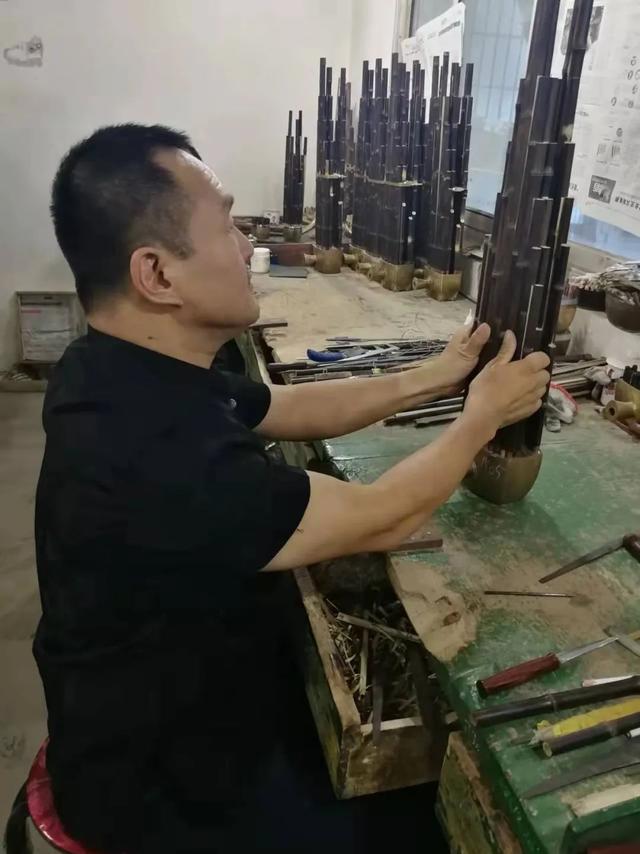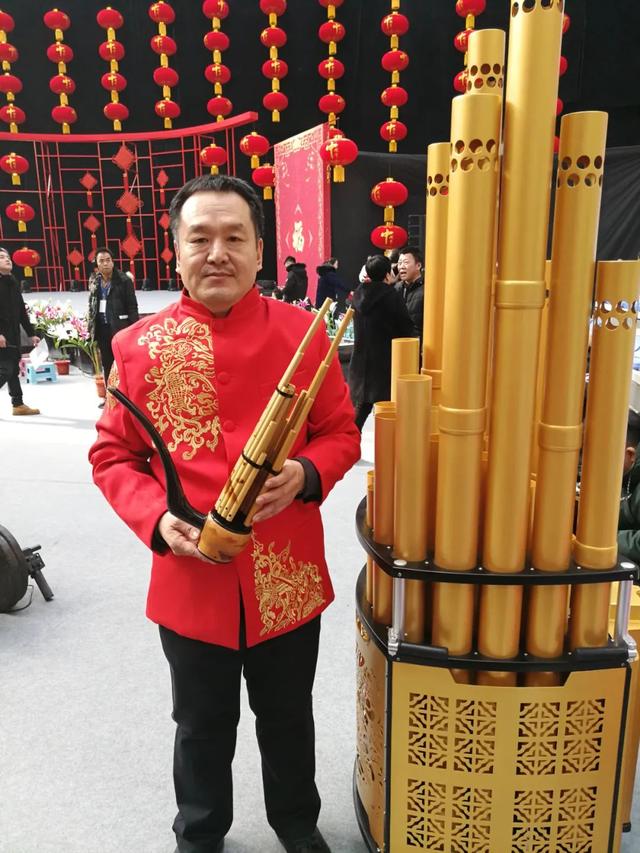The reform of "shengyin": let this ancient musical instrument have a new sound in modern bands
"Yo yo deer ming, eating wild apples. I have guests, and I play the sheng." The scene of entertaining guests in the "Book of Songs" has been celebrated for more than 2,000 years, and the sheng, an ancient Chinese reed instrument, also It has a history of more than three thousand years. "Sheng is not only an ancient and traditional musical instrument in China, but also contains the wisdom of China for thousands of years. The times are developing, so is the sheng, the times are changing, and the 'sheng sound' should also change. The sheng is timeless. Musical instruments." Sheng producer Zhao Hongliang plays, makes, and loves sheng. He is the third-generation successor of "Zhao Jiasheng". While inheriting the production skills of his ancestors, he has carried out a series of reforms and innovations on sheng, so that this ancient musical instrument can be revived in modern bands. new voice.

Follow the craftsmanship of ancestors
At the end of the Qing Dynasty, a boy surnamed Zhao from Nansi Village, Zhuozhou, Hebei, followed the band of the Qingsheng Temple near the village to learn to play and repair the sheng. Over time, Zhao Dongsheng learned a good craft of making sheng, and passed it on to his son Zhao Bochun. After the founding of New China, Zhao Bochun worked in the Beijing National Musical Instrument Factory, mainly engaged in the reform of musical instruments such as the key sheng and the plus key suona. After retiring, Zhao Bochun returned to his hometown in Nansi Village and passed on his sheng-making skills and experience to his younger generation.
"Grandpa returned to his hometown when he retired, and passed on all the sheng skills he accumulated in his life to me." Zhao Bochun's eldest grandson, Zhao Hongliang, is the third-generation descendant of "Zhao Jiasheng". Unique insights and production ideas. When he first started learning the Sheng system, Zhao Hongliang often turned his body on his side and polished the reeds finely for a whole day. Over time, his hands were covered with calluses, and it was not uncommon for his hands to be injured by tools. But when the reeds he polished by himself were installed in the sheng and made a wonderful sound, Zhao Hongliang was full of pride and fell in love with this business.
In the late 1980s, Zhao Bochun and Zhao Hongliang established Zhuozhou Hongliang Musical Instrument Factory, which was later renamed Zhuozhou Zhaojiasheng Musical Instrument Technology Co., Ltd. The company integrates the production, reform and innovation of musical instruments. It produces and sells more than 400 traditional and modern types of sheng every year, which are sold at home and abroad. "Doing a line, loving a line, doing it is the best, or don't do it." Zhao Hongliang follows the production process passed down by his ancestors to make a sheng. From raw materials to finished products, it has to go through tedious processes. In 2011, "Zhao Jiasheng Production Skills" was listed as a municipal intangible cultural heritage in Baoding, Hebei Province. In 2017, Zhao Hongliang proposed the "integration of intangible cultural heritage" and reached a consensus with the four intangible inheritors of Zhuozhou, Hebei Province, to integrate egg carving, jade ware, lacquer craftsmanship, gold and silver fine gold filigree inlay in the production process of "Zhao Jiasheng", making The resulting cultural and creative products endow the sheng with its modern meaning and artistic connotation as a traditional musical instrument.

Change "group" to "single"
With the development of folk music creation, like other traditional musical instruments, the limitations of the sheng have gradually become prominent - lack of bass, many works are difficult to complete, and reform is imminent. "For a long time, there have been no ethnic bass instruments in Chinese national bands. Our goal is to let the folk bands use Chinese national instruments, so that the folk bands live up to their name." In 2003, Zhao Hongliang set up a research and development team to concentrate on the development of mid-bass sheng.
The reeds of traditional Sheng share a sounding cavity. If you want to lower the pitch, you must enlarge the resonance chamber and widen the position, and the size of the hand is fixed, so there is no way to perform the reform. "How to increase the volume of the cavity without expanding the handle?" Zhao Hongliang thought about it day and night, and came up with a bold idea to separate the Shengdou and change the "group living" to "living alone", so that each spring Pieces have separate pronunciation chambers. However, after many trials, the desired sound could not be produced. "The reform of musical instruments is often accompanied by distress and failure. When I was developing the mid-bass sheng, I couldn't sleep day and night for two years. It was very painful. Finally achieved fruitful results - the alto, tenor, bass, and double bass are all thirty-six tones; they are arranged in a twelve-equal-tempered chromatic scale; the articulators and buttons are made of copper materials, and the amplifier tubes are made of horses. Limba-style aluminum metal material; single-row pronunciation chamber; the keys use multiple relay technology to increase kinetic energy, reduce key noise, and be flexible and beautiful. After several new technologies are used, the "sheng sound" can be lower, the tone is more beautiful, the volume is larger, the pitch and sensitivity are higher, and the convenience of instrument maintenance is also greatly improved.
Since then, "Zhao Jiasheng"'s key sheng, low-pitched and high-pitched sheng, together with its traditional sheng and reed sheng, have been widely used by professional performance groups such as the Chinese Orchestra, Hong Kong Chinese Orchestra, and Japan Chinese Orchestra, as well as higher music institutions such as the Central Conservatory of Music and China Conservatory of Music. used and received good reviews. The Oriental Chinese Orchestra of Wuhan Conservatory of Music is one of the first performance groups to use the "Zhao Jiasheng" series of key Sheng. "The practicability of the instrument and the overall tone, volume, and sound quality have reached a certain level. The supplementary effect of the mid-bass in the band is also very obvious." Professor Tan Jun of Wuhan Conservatory of Music commented that Zhao Hongliang injected the spirit of craftsman into the improvement of the sheng. Lots of blood. "Zhao Jiasheng" is well-made, pursues taste, and pays attention to craftsmanship. It is an excellent representative of the reform of Chinese musical instruments.
However, this research and development has made Zhao Hongliang a lot older. Because of the pressure, Zhao Hongliang lost a lot of hair, and his health turned red. After the research and development results were introduced to the market in 2013, he gave himself a two-year vacation to recuperate his body and did not dare to touch the musical instrument reform. I started to develop musical instruments, and sometimes I dreamed of improving it. Some innovations were inspired by dreams. I woke up and tried it immediately while my memory was clear. When he was too involved, he could only remind himself in his heart, "Don't be so intense anymore."
Tradition and modernity do not contradict
Since the birth of "Zhao Jiasheng", the reform and innovation of musical instruments has never stopped. Zhao Hongliang led the team to change the traditional sheng from the dead sheng to the live sheng, which provided a lot of convenience for users; the thirty-eight reed key sheng was reformed into a modern version of the key sheng with a new style that could be played standing up, which catered to the new folk music. The form of expression; the development of forty-two reed Sheng, which can play music with a wider range, etc. Sheng, an ancient musical instrument, gradually changed in Zhao Hongliang's hands.
In 2019, Zhaojiasheng Musical Instrument Museum was completed in Zhuozhou, Hebei. This is the first sheng-themed museum in China, with sheng as the main exhibits, including Chinese sheng culture, production and performance of sheng, etc. It is open to the public free of charge, popularizing knowledge of folk music, and carrying out folk music performances. There are all kinds of traditional sheng as well as modern improved sheng in the museum. "Tradition and modernity are not contradictory. We walk on two legs, not only changing the shape of the instrument that has been used for thousands of years into a musical instrument suitable for playing symphony, but also pursuing and restoring the ancient sheng." Zhao Hongliang said that the sheng is a traditional and ancient Chinese musical instrument. It carries and exudes the wisdom and cultural atmosphere of the ancestors.
In Zhao Hongliang's office, there is a simple and natural Sheng, a gourd Sheng bucket, and a bamboo reed. "Every year I plant a gourd, which is specially used to make Shengdou. If I find this gourd rack, I will find my home." While continuing to reform and innovate, Zhao Hongliang also pursued the ancients' way of making Sheng with the concept of advocating nature. . "I am currently busy copying the sheng of different periods in my country based on historical materials, and creating a sheng with modern literary rhythm based on the materials and shapes." Zhao Hongliang excavates the cultural connotation of the sheng, summarizes the characteristics of the utensils in each period, and sorts out the history of the sheng. development context. "Zhao Jiasheng" also launched a series of cultural sheng, in parallel with the series of modern sheng, traditional sheng, and mid-bass sheng.
Involving musical instruments
Guess you like
Hot news
- 01 Echoes of history and artistic narration of music: In-depth analysis and cultural connotation exploration of the famous Pipa song "House of Flying Faces"
- 02 The difference between cymbals and cymbals in ethnic musical instruments
- 03 Pipa famous song "Overlord Unarmor" : historical picture and heroic lament in music
- 04 "Drunken Fishing Singing Late" -- the perfect fusion of t"High Mountains and Flowing Water" -- the profound friendship and artistic spirit behind the ancient qin music of Boya's mournihe taste of life and the natural artistic conception in the Guqin music
- 05 Sunset Flute and Drum - A Deep Interpretation of the Poetic and Artistic Conception and Music Narration in Ancient Pipa Songs
 渝公网安备 50010702504639号
渝公网安备 50010702504639号